Guidelines for the treatment of psoriatic arthritis with biologics
Guidelines for the treatment of psoriatic arthritis with biologics
Guidelines for the treatment of psoriatic arthritis with biologics
You also want an ePaper? Increase the reach of your titles
YUMPU automatically turns print PDFs into web optimized ePapers that Google loves.
appropriate monitoring under <strong>the</strong> care <strong>of</strong> a Hepatologist or HIV specialist. (Grade B).<br />
Consensus score 8.9<br />
• Anti‐TNF <strong>the</strong>rapy in those <strong>with</strong> chronic HBV should be approached <strong>with</strong> caution given <strong>the</strong><br />
potential risk <strong>of</strong> reactivation and fulminant hepatitis. Anti‐TNF <strong>the</strong>rapy should only be<br />
commenced in those <strong>with</strong> well controlled disease, <strong>with</strong> appropriate antiviral <strong>treatment</strong> and<br />
regular monitoring in collaboration <strong>with</strong> a Hepatologist. Consideration should be given to<br />
vaccinating those at risk <strong>of</strong> HBV prior to <strong>treatment</strong>. (Grade C). Consensus score 9.5<br />
Malignancy<br />
Observational and registry data has been reassuring in showing no increase in <strong>the</strong> rate <strong>of</strong> overall malignancy<br />
related to anti‐TNF <strong>the</strong>rapy. Meta‐analysis <strong>of</strong> registry data in RA has shown no increase in overall malignancy<br />
(risk estimate 0.95, 95% CI 0.85,1.05) or lymphoma (risk estimate 1.11, 95% CI 0.70, 1.51) when comparing<br />
patients exposed to anti‐TNF <strong>the</strong>rapy <strong>with</strong> those exposed to standard DMARDs [73]. Very little is known about<br />
<strong>the</strong> risk <strong>of</strong> using anti‐TNF <strong>the</strong>rapy in patients <strong>with</strong> a previous malignancy. These patients are excluded from<br />
clinical trials and are generally not considered <strong>for</strong> <strong>treatment</strong> <strong>with</strong> anti‐TNF <strong>the</strong>rapy in clinical situations. Data<br />
from <strong>the</strong> German and British registry showed a combined incidence rate ratio <strong>of</strong> 0.62 (95% CI 0.04, 1.20) but<br />
this was based on a small number <strong>of</strong> cases and selection bias in those treated <strong>with</strong> anti‐TNF <strong>the</strong>rapy following<br />
a malignancy is likely to be significant [73].<br />
Registry data in RA has confirmed an increased risk <strong>of</strong> skin cancer associated <strong>with</strong> anti‐TNF use, both nonmelanoma<br />
skin cancer and malignant melanoma [73, 74]. Skin cancers are very common in <strong>the</strong> general<br />
population (60,000 new cases registered in England and Wales each year) and basal cell carcinoma (BCC),<br />
squamous cell carcinoma (SCC) and malignant melanoma (MM) account <strong>for</strong> 95% <strong>of</strong> all cases [75]. People <strong>with</strong><br />
PsA <strong>with</strong> significant skin disease may be at fur<strong>the</strong>r increased risk (in addition to that <strong>of</strong> anti‐TNF <strong>the</strong>rapy) due<br />
to self directed excess ultraviolet (UV) exposure or as a result <strong>of</strong> photo<strong>the</strong>rapy, particularly PUVA (psoralen<br />
and UVA) [76]. Long term immunosuppression <strong>with</strong> agents such as ciclosporin and azathioprine may<br />
compound this risk, especially <strong>for</strong> squamous cell carcinomas [77, Paul, 2003 #1626] However, <strong>the</strong> death rate<br />
associated <strong>with</strong> <strong>the</strong> majority <strong>of</strong> skin cancers is very low, early detection significantly improves both morbidity<br />
and mortality, and most are completely cured <strong>with</strong> local, predominantly surgical, measures.<br />
Recommendations<br />
• Anti‐TNF <strong>the</strong>rapy should be avoided in patients <strong>with</strong> a current or prior history <strong>of</strong> malignancy<br />
unless <strong>the</strong> malignancy was diagnosed and treated more than ten years ago and/or where <strong>the</strong><br />
likelihood <strong>of</strong> cure is high. All patients should be encouraged to participate in national cancer<br />
screening programmes appropriate <strong>for</strong> <strong>the</strong>ir age and gender. Patients on anti‐TNF should be<br />
regularly screened <strong>for</strong> skin cancers (including melanoma) especially if <strong>the</strong>ir background risk is<br />
high and patients who develop suspicious skin lesions whilst on TNF <strong>the</strong>rapy should be<br />
referred <strong>for</strong> urgent dermatological review and management. Anti‐TNF <strong>the</strong>rapy is relatively<br />
contra‐indicated in patients who have had prior <strong>treatment</strong> <strong>with</strong> >150 PUVA and/or >350 UVB<br />
<strong>treatment</strong>s, especially when this has been followed by <strong>treatment</strong> <strong>with</strong> ciclosporin and should<br />
be <strong>for</strong>mally reviewed by a Dermatologist where <strong>the</strong>rapy cannot be avoided. (Grade C).<br />
Consensus score 9.4<br />
Demyelination<br />
13
















